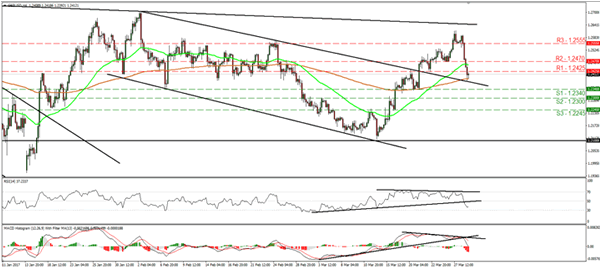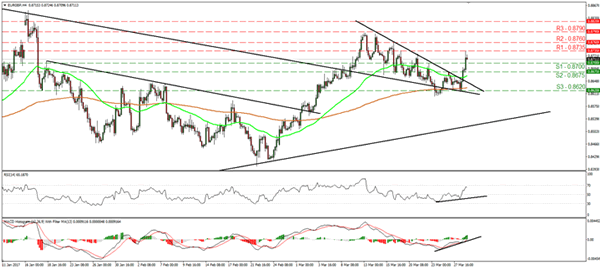The British pound took a serious hit yesterday, after a cocktail of economic and political news. The first piece of news came from the BoE. Ian McCafferty, one of the most hawkish members of the MPC, said that the UK economy is not ready for hikes right now. These cautious comments may have come as a surprise to investors, and may have pushed back expectations regarding the timing of a potential BoE tightening.
Then, it was all political news. The Scottish Parliament voted in favor of a second independence referendum. Nonetheless, the UK government quickly announced that it will not allow something like that for a while, at least not until a deal between the UK and the EU is reached.
Later in the day, it was Theresa May’s turn. The PM signed the Article 50 letter, starting the official process for leaving the EU. This marks the beginning of two years of negotiations between the two sides. Today, PM May will speak before Parliament, and EU Council President Donald Tusk will hold a press conference in response to May’s letter. As such, we expect the pound to remain exposed to comments from these two officials.
GBP/USD tumbled, falling below the inside swing low of 1.2555 (R3) to hit support at the prior resistance line taken from back at the peak of the 2nd of February. We expect investors to await near that area, or at least stay above the support of 1.2340 (S1), until we get any key remarks from May or Tusk.
Looking ahead, we expect sterling’s forthcoming direction to be determined to a large extent by headlines around the negotiations, especially on the subject of trade. Signs that the UK is likely to end up with no free trade agreement could lead to further downside in the pound. Nonetheless, given that much of the "hard Brexit" rhetoric may already be priced into the battered pound, we believe that the political risks surrounding GBP are likely asymmetrical. Any positive developments during the negotiation process could generate a bigger upside reaction than the corresponding downside in case of the anticipated "hard Brexit" outcome.
EUR/GBP shot up yesterday, breaking above the upper bound of a falling wedge formation that contained the price action since the 9th of March. This has turned the short-term outlook to the upside and as such we expect the rate to challenge once again the 0.8735 (R1) resistance soon. A break above that line is possible to aim for our next obstacle of 0.8760 (R2), marked by the peak of the 16th of March.
US dollar makes a comeback
The other currency to experience a big movement yesterday was the greenback, which recovered some lost ground. Although there was no clear fundamental catalyst behind the recovery, we see three factors that could be behind the move. Firstly, Fed Vice Chair Fischer confirmed that he expects another two rate hikes this year, which may have eased the concerns of some investors following the not-so-hawkish hints from Chair Yellen after the March FOMC meeting. Secondly, the Conference Board consumer confidence index unexpectedly surged to a level last seen in 2000, and finally, the fact that Q1 is almost over means that there may have been some end-of-quarter USD demand, as investors rebalance their portfolios.
With regards to the greenback, we think that its outlook remains neutral right for now. We will reevaluate our view when we get hints with regards to the timing of the next rate hike, and updates on the timing and size of Trump’s tax reforms. We believe that short-term paths in USD pairs will depend primarily on the counterparts. For example, we expect USD to underperform EUR, which is likely to remain supported on speculation that the era of ultra-loose monetary policy in the Eurozone is approaching an end. On the other hand, we expect it to outperform CAD, given a very dovish BoC.
As for today’s economic indicators
During the European day, the calendar is relatively light. From Sweden, we get the consumer and manufacturing confidence indices, both for March. Nonetheless, neither of these indicators is usually a major market mover.
From the US, we get pending home sales for February. The forecast is for the figure to have risen, a rebound from the previous month.
As for the speakers, we have four on the schedule: Chicago Fed President Charles Evans, Boston Fed President Eric Rosengren, San Francisco Fed President John Williams and ECB Executive Board member Peter Praet.
GBP/USD

Support: 1.2340 (S1), 1.2300 (S2), 1.2245 (S3)
Resistance: 1.2425 (R1), 1.2470 (R2), 1.2555 (R3)
EUR/GBP

Support: 0.8700 (S1), 0.8675 (S2), 0.8620 (S3)
Resistance: 0.8735 (R1), 0.8760 (R2), 0.8790 (R3)














